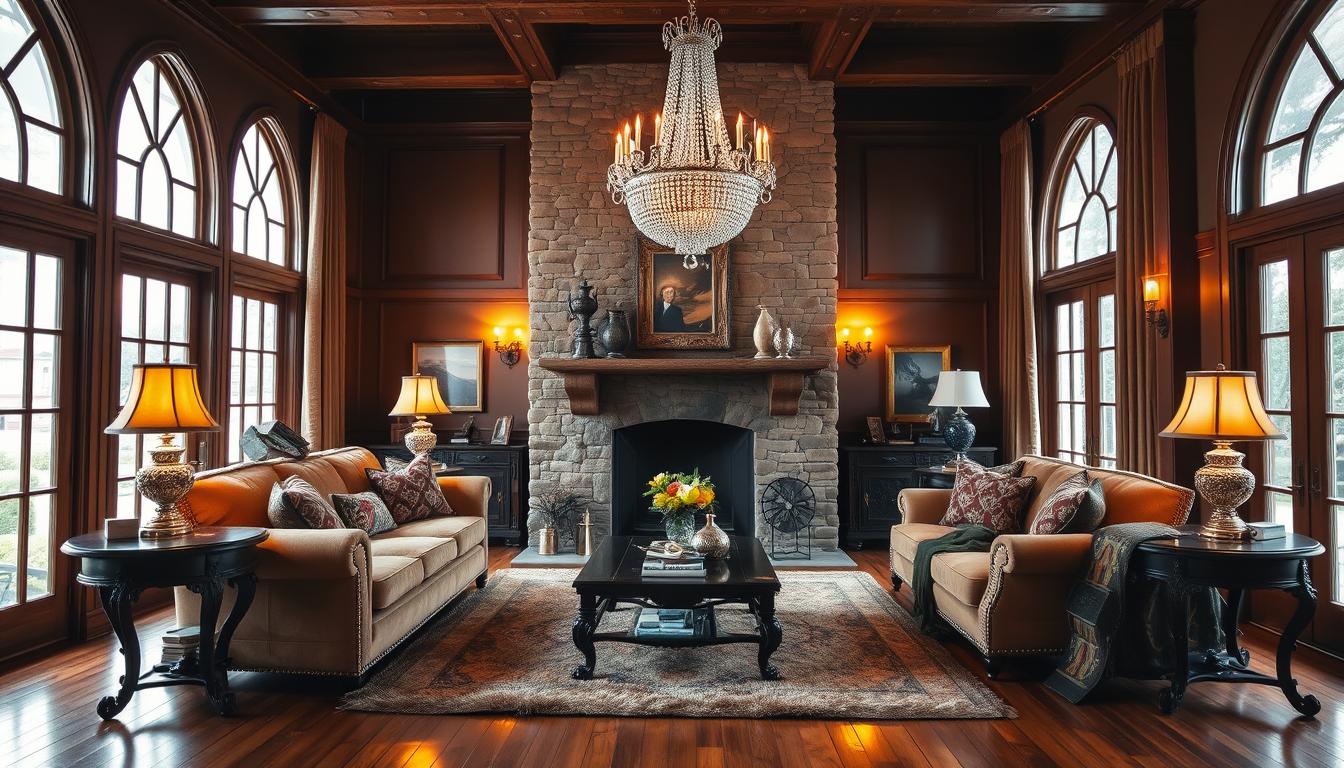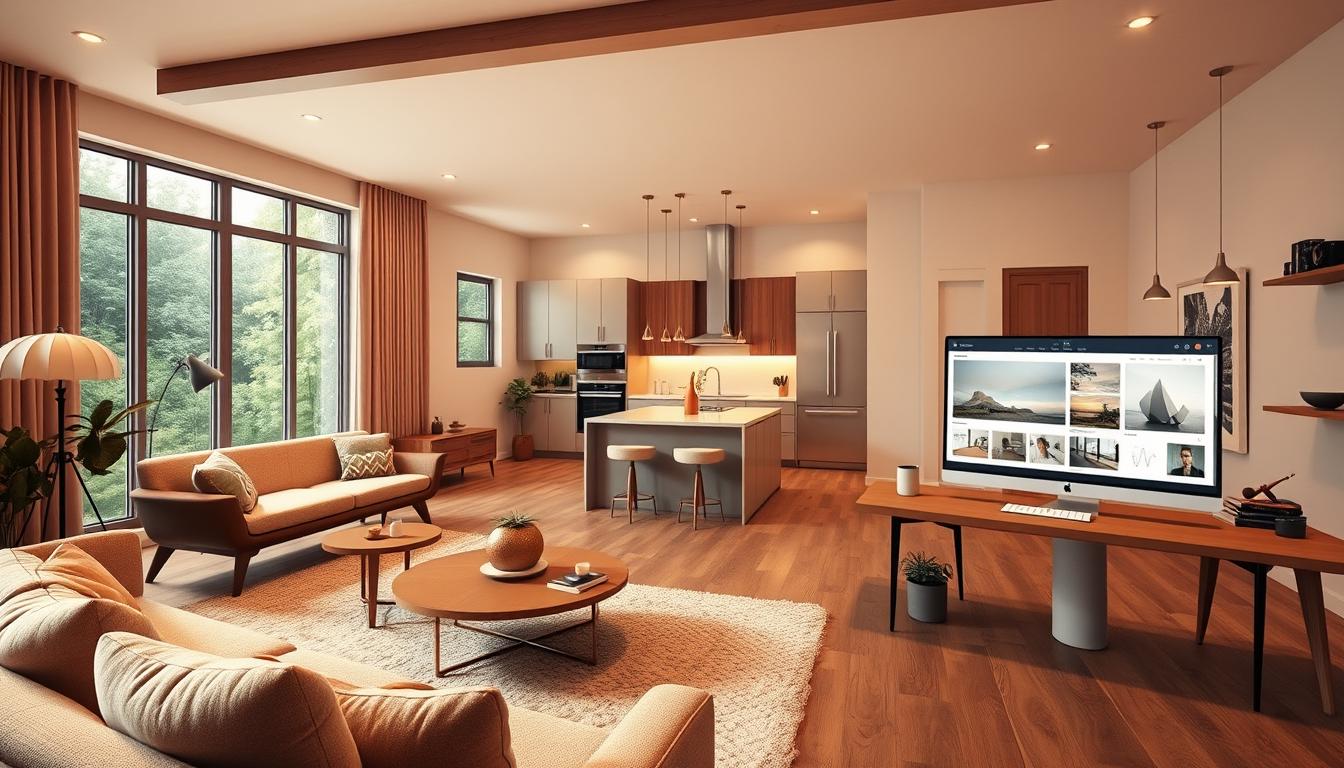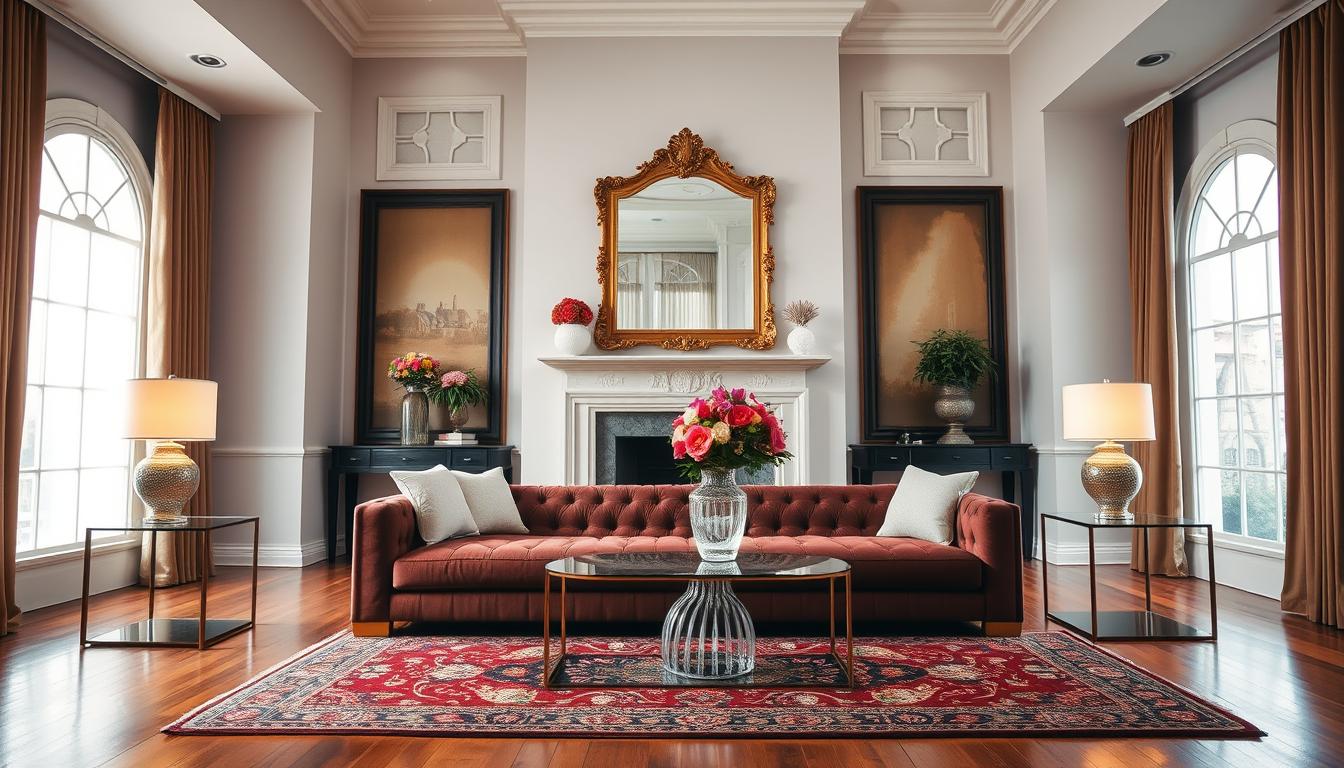We often find comfort in the warmth of classic home decor. It shows the lasting charm of timeless interiors. These spaces bring a sense of comfort and familiarity, loved by many.
At the core of these beloved homes is a mix of traditional and thoughtful design. This mix creates a welcoming atmosphere. We will dive deeper into what makes traditional homes and interiors so appealing.
Key Takeaways
- Classic home decor offers a timeless charm that many find appealing.
- The comfort and familiarity of traditional interiors make them a popular choice.
- A blend of traditional elements and thoughtful design creates a unique atmosphere.
- These homes evoke a sense of warmth and character.
- The enduring appeal of traditional homes lies in their ability to balance classic elements with modern sensibilities.
The Essence of Traditional Homes
Traditional homes blend vintage design with timeless interior styling. They have classic elements passed down through generations. This creates a warm, elegant, and heritage-rich atmosphere.
What Defines a Traditional Home?
Traditional homes have symmetrical facades and balanced windows. They often have grand entrances with detailed designs. Sometimes, they feature elegant columns, enhancing their classic appeal.
The interiors of these homes are stunning. They have:
- Classic color schemes that feel warm and cozy
- Rich textiles and fabrics for depth and texture
- Furniture that reflects historical styles, like Victorian or Colonial Revival
Experts say, “Traditional homes are more than buildings. They are history and culture, sharing past stories through design.”
“The beauty of traditional architecture lies in its ability to evoke a sense of nostalgia and connection to the past.”
| Characteristic | Description |
|---|---|
| Symmetrical Facades | A balanced exterior that creates a sense of order and harmony |
| Grand Entrances | Ornate detailing and sometimes elegant columns that make a statement |
| Classic Color Palettes | Timeless hues that evoke warmth and coziness |
Historical Significance in Architecture
Traditional homes reflect historical architectural styles. They show the cultural and social influences of their time. By keeping these elements, homeowners connect to the past while enjoying modern comforts.
The historical value of traditional architecture goes beyond looks. It’s about the stories these homes tell. By using timeless interior styling, we create beautiful spaces and preserve history.
Popular Architectural Styles
Styles like Colonial Revival, Craftsman Bungalows, and Victorian Elegance shape our traditional homes. They show the history and culture of their times. They also make each home unique.
Let’s look at these architectural styles and their special features.
Colonial Revival
The Colonial Revival style looks back to America’s early days. It has symmetrical fronts, evenly spaced windows, and classic touches like pilasters. It often uses antique furnishings to add to its historical feel.
Colonial Revival homes are known for:
- Rectangular shape with a central front door
- Multi-paned windows
- Decorative elements like cornices and friezes
Craftsman Bungalows
Craftsman Bungalows are cozy and welcoming. They have low-pitched roofs, wide eaves, and decorative trusses. Inside, you’ll find rustic furnishings and built-in cabinets.
Key features of Craftsman Bungalows are:
| Feature | Description |
|---|---|
| Roofing | Low-pitched gabled roofs |
| Eaves | Wide eaves with decorative trusses |
| Porch | Inviting porches with sturdy columns |
Victorian Elegance
Victorian homes are known for their detailed designs and mix of styles. They have complex shapes, patterned masonry, and bright colors. Inside, you’ll see intricate moldings and fancy furnishings.
“The Victorian era’s architectural innovations were a reflection of the period’s cultural and industrial advancements, resulting in homes that were both functional and aesthetically striking.”
Victorian homes stand out with:
- Complex roof shapes with multiple gables
- Ornate woodwork and patterned masonry
- Vibrant, multi-colored exterior paint schemes
Key Elements of Traditional Interiors
Traditional interiors have certain key elements that define their look and feel. These elements work together to create a warm and inviting atmosphere. This is what makes traditional design so special.
Classic Color Palettes
Classic color palettes are a key feature of traditional interiors. These palettes include muted tones like beige, cream, and soft pastels. They create a soothing and calming environment. Neutral backgrounds let richer, deeper colors from furniture and decor add depth and interest.
For example, a traditional living room might have walls in soft cream. It’s complemented by rich wood tones and deep red accents from furniture and rugs. This mix creates a cozy and inviting atmosphere that’s quintessentially traditional.
| Color | Effect | Example |
|---|---|---|
| Soft Cream | Creates a neutral background | Walls, trim |
| Deep Red | Adds warmth and depth | Rugs, accent furniture |
| Rich Wood Tones | Brings warmth and coziness | Furniture, paneling |
Textiles and Fabrics
Textiles and fabrics are crucial in traditional interiors. They add texture, warmth, and visual interest. Luxurious fabrics like velvet, silk, and linen are often used. These materials feel luxurious and add sophistication to the room.
For instance, velvet sofas and armchairs can be the centerpiece of a traditional living room. Silk drapes add elegance and refinement. The mix of different textures and fabrics creates a rich and layered look.
Furniture Styles
The furniture in traditional interiors is characterized by classic styles. These pieces are made from high-quality woods and have intricate details like carvings and moldings. Ornate details and comforting shapes are hallmarks of traditional furniture. They create a sense of warmth and hospitality.
For example, a traditional dining room might have a large, ornate wooden table surrounded by matching chairs. This creates a sense of formality and elegance. Classic furniture pieces help define the traditional aesthetic and connect us to the past.
Incorporating Antique Furniture
For those who love timeless interior styling, antique furniture is a goldmine. It adds sophistication and history to traditional homes, making them stand out.
Adding antique furniture to our homes is more than just decoration. It brings stories and histories into our spaces. This can make our classic home decor more elegant and full of character.
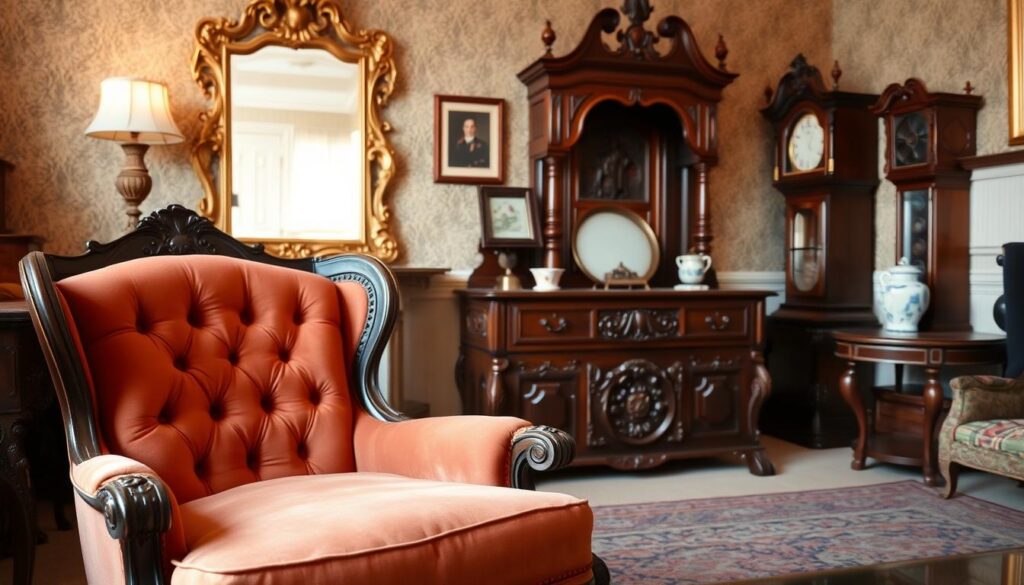
Finding Quality Antiques
Finding good antiques takes time, research, and a sharp eye. Start by visiting local antique shops, estate sales, and online marketplaces. Look for signs of quality, like dovetail joints and solid wood.
When checking an antique, think about its condition, rarity, and history. Knowing its background can change its value and how it looks in your home.
Restoration Tips for Longevity
Restoring antiques needs care and a focus on keeping its original look. Use traditional methods and materials to keep it real. For example, reupholstering a chair with the right fabric keeps its authenticity.
To keep your antiques in good shape, regular care is key. Dust gently, avoid direct sunlight, and use coasters and placemats to protect surfaces.
By adding antique furniture to our homes and caring for it, we create a space that’s not just beautiful. It’s also filled with history and character.
Warmth and Comfort in Design
In traditional home design, the focus is on making spaces warm and cozy. This is done by carefully choosing materials, textures, and furnishings. These elements work together to create a welcoming feel.
Utilizing Natural Materials
Natural materials are key in adding warmth to traditional homes. Wood, stone, and brick are favorites for their look and durability. Wooden beams and stone fireplaces, for example, can make a room feel historic and unique.
Using natural materials also connects us to the outdoors. It brings calm and serenity inside. Interior design experts say, “Natural materials make a space feel grounded and cozy.”
“The use of natural materials in design not only enhances the aesthetic appeal of a home but also contributes to a sense of warmth and well-being.”
| Material | Characteristics | Uses in Traditional Design |
|---|---|---|
| Wood | Warmth, durability, versatility | Furniture, flooring, paneling |
| Stone | Durability, elegance, natural beauty | Fireplaces, flooring, walls |
| Brick | Timeless appeal, durability, insulation | Exterior walls, fireplaces, pathways |
Layering Textures for Coziness
Layering different textures is crucial for a cozy atmosphere in traditional homes. This means combining smooth and rough textures, or mixing old and new designs.
For instance, a rustic wooden table with smooth leather chairs and plush rugs can make a dining room interesting. Throw blankets and pillows in various textures also add to a living room’s coziness.
By carefully layering textures and using natural materials, homes become warm and inviting. This approach makes a home look good and feel relaxing. It’s all about creating a space that feels both stylish and comfortable.
Color Schemes That Resonate
In traditional design, some color schemes have lasted for ages. They bring a sense of continuity and familiarity. These colors not only make a home look good but also feel warm and welcoming.
Choosing the right color scheme is key for traditional interiors. Timeless neutrals and inviting earth tones are top picks. They work well with antique furnishings and elegant home accents, creating a classic look.
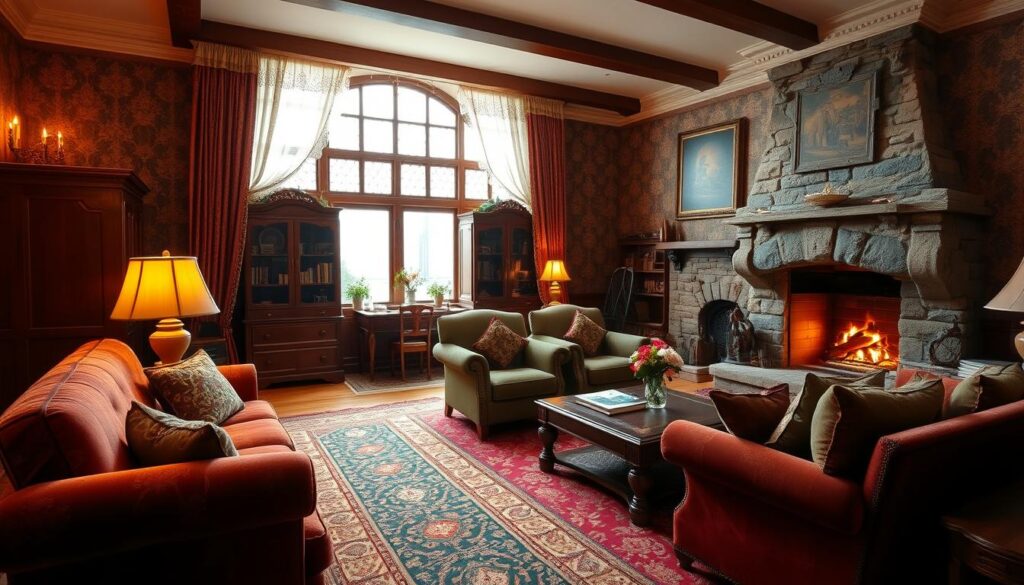
Timeless Neutrals
Beige, cream, and soft gray are essential in traditional design. They offer a clean, elegant space for antique furnishings and decor. Neutral tones are versatile, making it easy to add textures and patterns for depth and interest.
- Beige and cream shades create a warm, inviting atmosphere.
- Soft grays provide a sophisticated, calming feel.
- Neutral backgrounds let statement pieces shine through furniture and decor.
Inviting Earth Tones
Earth tones like green, blue, and terracotta add warmth and coziness to traditional interiors. These colors remind us of nature, creating a soothing, comforting space. Paired with elegant home accents, earth tones add sophistication and elegance.
- Terracotta shades bring warmth and rustic charm.
- Muted greens and blues offer a calming, serene atmosphere.
- Earth tones work well with natural materials like wood and stone for a cohesive look.
Using timeless neutrals and inviting earth tones in your color scheme makes your home classic and welcoming. These palettes are a great base for adding antique furnishings and elegant home accents. Your home will then exude warmth and sophistication.
Modern Takes on Traditional Design
Mixing modern styles with traditional ones makes for a special living space. It’s not just old and new together. It’s about finding a balance that brings out the best in both.
Adding modern touches to traditional homes refreshes them. It keeps their timeless charm while showing off personal style. This makes every home truly unique.
Blending Contemporary with Classic
Combining modern and traditional design needs careful thought. Choose modern items that fit well with your home’s old features. For example, sleek lights or modern art can make traditional decor pop.
Key Elements to Consider:
- Mixing modern furniture with traditional pieces
- Incorporating contemporary color schemes
- Using modern textiles and patterns
Here’s a comparison of traditional and modern design elements to consider when blending styles:
| Design Element | Traditional | Modern |
|---|---|---|
| Furniture | Ornate, carved wood | Sleek, minimalist |
| Color Scheme | Warm, rich tones | Neutral, bold accents |
| Textiles | Heavy, patterned fabrics | Light, simple weaves |
Innovative Space Utilization
Modernizing traditional homes means using space wisely. It’s about making the most of what you have without losing the classic feel. Use furniture that does more than one thing, optimize storage, and create open spaces.
For example, hidden storage or multi-use furniture can greatly improve a room’s function.
By mixing modern and traditional, homeowners can create a welcoming space. It shows off their unique style.
Personalizing Your Traditional Home
We think a traditional home is special because you can make it your own with meaningful items. Adding personal touches can turn a house into a home. It becomes unique and shows off the stories and histories of its owners.
Family Heirlooms and Their Stories
Family heirlooms are key in making a home personal. These items, passed down through years, hold stories and memories. They add depth and character to your home’s look.
For example, an old clock or a vintage piece of jewelry can be a room’s centerpiece. They start conversations and bring people together.
When you add family heirlooms to your home, think about their history and the memories they bring. Show them off or use them in daily life. It makes your space feel more personal. Also, share the stories behind these items with your family. This keeps their importance alive for the future.
Curation of Décor
Choosing your home’s décor is also important. It’s about picking items that show your style and interests. A well-chosen space can mix old and new, creating a unique vibe.
To pick the right items, start by thinking about what you like. Look for pieces that match your style, like art or collectibles. Make sure they fit with your home’s colors and size. This way, you create a space that feels welcoming and truly yours.
Personalizing your home is about making it tell your story. By using family heirlooms and carefully choosing your décor, you make a home that’s beautiful and meaningful. It shows off your heritage.
Outdoor Spaces and Traditional Aesthetics
Outdoor areas in traditional homes are more than just extra space. They show off timeless beauty. Traditional looks are key to making these spaces beautiful and useful.
Landscaping and patio design are crucial for outdoor spaces. They help make these areas welcoming and match the traditional home.
Classic Landscaping Ideas
Classic landscaping mixes nature with design. Rustic furnishings and natural things make outdoor spaces look traditional.
- Use native plants and flowers for a natural look.
- Paths of natural stone or brick add character.
- Hedges and topiaries bring formality.
These features not only look good but also link the house to the landscape.
Creating Inviting Patios
Patio design is vital in traditional homes. To make a patio welcoming, add antique furnishings and classic touches.
| Design Element | Description | Benefit |
|---|---|---|
| Rustic Furniture | Choose wooden or wrought iron furniture with a worn look. | It adds warmth and character. |
| Classic Patterns | Use traditional patterns like stripes or florals in outdoor fabrics. | It makes the space timeless and inviting. |
| Ambient Lighting | Use lanterns or string lights for soft, warm light. | It improves the atmosphere and lets you enjoy the outdoors at night. |
With these elements, we can make outdoor spaces beautiful, useful, and welcoming.
Sustainable Practices in Traditional Homes
We can enjoy traditional homes while being kind to the planet. This way, we keep their classic charm and make them eco-friendly.
Using eco-friendly materials is key. These are materials that are good for the environment. Think reclaimed wood, bamboo, and paints that don’t harm the air. They cut down on pollution and make homes healthier.
Eco-Friendly Materials
Choosing the right materials is important when renovating or building. Reclaimed wood adds character and saves trees. Bamboo flooring is great because bamboo grows fast.
- Reclaimed wood for flooring and walls
- Bamboo flooring for its durability and sustainability
- Low-VOC paints to improve indoor air quality
- Recycled metal for roofing and decorative elements
Energy-Efficient Upgrades
Energy-efficient upgrades are also important. They save energy and money. Think of installing new windows, LED lights, and better insulation.
Energy-efficient windows keep homes cool in summer and warm in winter. This means less need for heating and cooling.
- Install energy-efficient windows to reduce heat transfer
- Upgrade to LED lighting for reduced energy consumption
- Improve insulation to maintain a consistent indoor temperature
- Use smart home technology to monitor and control energy usage
These upgrades make homes cozy and green.
In short, making traditional homes sustainable is smart. It helps the planet and keeps homes charming.
Resources for Traditional Design Inspiration
If you’re looking for timeless interior styling, there are many resources to explore. You can find classic home decor inspiration through various media. This can help you discover new ideas and approaches to traditional design.
Publications and Print Media
Magazines like House Beautiful, World of Interiors, Elle Décor, and Architectural Digest are great. They offer a lot of information on traditional design. You’ll see many styles and influences.
Digital Communities
Online forums and social media groups focused on traditional design are also valuable. They let you share ideas, ask questions, and learn from others. It’s a great way to connect with people who love classic home decor.
